0. 1/28/2012 – Art Attack Call for Submissions, by Riese
1. 2/1/2012 – Art Attack Gallery: 100 Queer Woman Artists In Your Face, by The Team
2. 2/3/2012 – Judy Chicago, by Lindsay
3. 2/7/2012 – Gran Fury, by Rachel
4. 2/7/2012 – Diane Arbus, by MJ
5. 2/8/2012 – Laurel Nakadate, by Lemon
6. 2/9/2012 – 10 Websites For Looking At Pictures All Day, by Riese
7. 2/10/2012 – LTTR, by Jessica G.
8. 2/13/2012 – Hide/Seek, by Danielle
9. 2/15/2012 – Spotlight: Simone Meltesen, by Laneia
10. 2/15/2012 – Ivana, by Crystal
11. 2/15/2012 – Gluck, by Jennifer Thompson
12. 2/16/2012 – Jean-Michel Basquiat, by Gabrielle
13. 2/20/2012 – Yoko Ono, by Carmen
14. 2/20/2012 – Zanele Muholi, by Jamie
15. 2/20/2012 – The Malaya Project, by Whitney
16. 2/21/2012 – Feminist Fan Tees, by Ani Iti
17. 2/22/2012 – 12 Great Movies About Art, by Riese
18. 2/22/2012 – Kara Walker, by Liz
19. 2/22/2012 – Dese’Rae L. Stage, by Laneia
20. 2/22/2012 – Maya Deren, by Celia David
21. 2/22/2012 – Spotlight: Bex Freund, by Rachel
22. 2/24/2012 – All the Cunning Stunts, by Krista Burton
![]()
an interview conducted by Krista of Effing Dykes and originally published in the All the Cunning Stunts publication SO GAY!
A long short time ago, in a land at least two mean-ass ten-hour flights away from the global hubs of contemporary art, four artists of les-sure united to produce All the Cunning Stunts, a 16-panelled, urban light-box artwork of multiplied, monolithic proportions in Wellington, New Zealand. It was nice.
One year later, Liz Allan, Clare Noonan, Rachel O’Neill and Marnie Slater are still working together under the collective name All the Cunning Stunts (AtCS), and have just released their new publication SO GAY!, which documents their recent public art project, taking their love of colour, low-tech Photoshop kinks, queer-positive sloganisms and collective laughter from the homo-local to the universal.
Read on for a sneak peak of SO GAY! as effingdykes.blogspot.com queen Krista Burton employs her finely tuned curiosity in an email interview with AtCS, producing a rainbow of responses from the artists and elucidating their process of queering it up at street level.
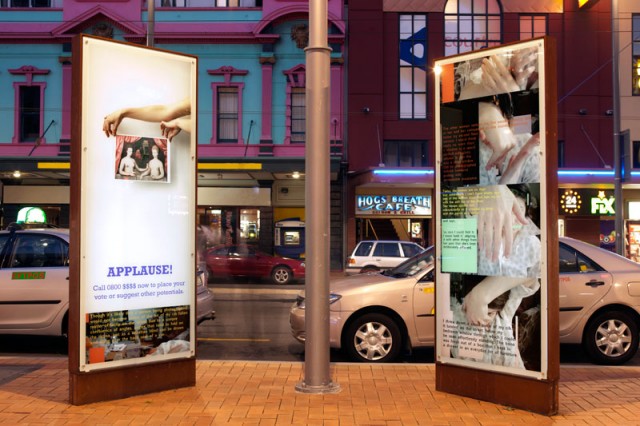
Who are you guys? What is this? Is your identity a secret?
Liz: We don’t conceal our (superhero) identities like the Guerrilla Girls do, but as it was our first outing we took an interest in manipulating our representation as ‘gay artists’.
Marnie: But in terms of our collaboration, there is no intentional hiding of identity – perhaps more of a willfully conversational mode of making. Actually, when we were first approached for the light box project by curator Mary-Jane Duffy, it was as individual artists. We have been friends for eons, but never really considered working as an artistic group before – Clare and I are partners and we’ve always flatly denied we would or could work collaboratively! But in response to the curatorial brief to respond to the notion of ‘contemporary homosexuality’, I really felt that working as a group would in a way let us imagine, as well as attempt to represent, contemporary homosexuality.
Rachel: Yeah, who we are is also what we do. We come together from across the seas (usually via Skype as we live on different continents), and after having a short gossip (is that a new haircut?) we knock three times on an agenda, say some magic words, and then enter All the Cunning Stunts ‘studio’ aka our virtual meeting place slash private gay shroud in which we make collaborative decisions. This part is always free of full stops and full of surprises.
Sorry to be obnoxious, but – you’re from New Zealand? (I bet you have fucking great accents. Jealousy. I traveled once with a woman from New Zealand. She was unbelievably chill and she pronounced the word ‘fair’ as ‘fee-ah’.)
Liz: That accent sounds a bit Australian to us, ‘fair’ should sound more like ‘fee-uh’? But yup – between us our hometowns span the length of Niu Zullund – and national characteristics definitely include chullness and travel.
Marnie: Whun I furst caeme to the Nuetherlunds to studie I got a lut of shuit for miy auccient. Werds luike bed und egg wure toutullie umpoassable. Then I started to neutralise my vowels. My mum and dad say I sound pompous. Linguistic survival is a cruel master.
Clare: It’s funny because in the works and on the blog we kind of went crazy for more global (less idiosyncratic) linguistic now-speak, i.e. it’s the shiz, effing, er, book. We also relished those heavily social networked acronyms – LOL, ROTFLOL, OMG. Then came the addiction to the bold, confident, but un-simplified language of advertising and hyper pop gestures – OUT NOW, CALL 0800, WE RECRUIT. But yeah, we do make some special ‘kiwi’ references – in our letter to the Topp Twins we don’t like email it, rather we post it on the ‘yodelling grapevine’ (FYI this is how lesbian yodellers share news in our fee-uh country).
What’s the queer scene like over there? Was this project shocking in any way?
Liz: Well, in comparison to Chicago’s queer scene where your blog is based, Wellington’s is small, dispersed and, in my social group at least, quite integrated into the het scene. There are a few bars, an annual film festival, some public-figure gays, and some public handholding (is that enough for a scene?). As a smaller community we are not big enough to support the populous gay-topia culture you portray in effingdykes.
Clare: I think it depends on which city, town, or community you are speaking of. When I returned to my home city of Christchurch for a year, I felt a lack of visibility of outward gay culture both on the streets and within my own immediate social and arts community. The need to find it somewhere became increasingly important. While believing that it remained to be found in the covert local, I fell into the treasure trove of an ‘invisible community’ – finding, er, stalking music and blog cultures online.
Marnie: I remember the first time I visited a gay bar in Wellington. I was really just coming out – I don’t think I had told my family at this stage. Anyway, my girlfriend took me along to a lesbian night, and all I remember is (small) groups of either nervous looking emo lesbians, or super butch, crew-cut styles with white t-shirts tucked into blue jeans. Oh, and the music was bad. I think in Wellington, the queer bar scene is quite gay male-focused, or at least the music and atmosphere are targeted at a specific part of the gay community. The feminist punk and music scene in Wellington is really exciting though, and lots of great parties and gigs happen in connection with them.
Liz: In terms of how people responded to the project, most of the queer folk I know are in creative fields and their responses were super positive, but it was definitely a daunting prospect thinking about the range of perspectives we might be speaking to and, by default, for.
Rachel: Our project launched the cultural wing of the 2nd AsiaPacific Outgames, where 2000 international visitors came to Wellington primarily to play sport and party. We knew there would be a queer audience for the work, but not wanting to make assumptions, we talked a lot about who the local/visiting LGBTQI viewing community would be. All n’ all, to get things going we decided to narrow our homosexual focus so to speak, and our starting point became ‘female same-sex experience’. We also decided to have as much fun as all the sporty people. What we really wanted was to start conversations. And we genuinely wanted to make work for a queer audience and focus on how communities are shaped by the desires and actions of the people involved, making them full of potential direction. We hoped an invitational tone would encourage dialogue rather than rehash stereotypes of belonging or difference.
Clare: For sure, I think the moment you speak through difference, it immediately confirms a border between what’s included and excluded. Besides it not being as simple as that, I think we sincerely wanted to jump into the melting pot.
The spoonerised mind-your-Cs-and-Ss name of our collaboration – AtCS – caused a moment of over sensationalised news stir in Wellington’s main newspaper, missing some of the homage aspects to the continuum of all sincerely cunning stunts (people and actions, past, present, and potential). To refer to ‘all the cunning stunts’ is inclusive and multiple, and especially important in re-iterating the consciousness that Liz mentioned we had about who we might be speaking to, by default for… and in this case with!
Rachel and I often find ourselves talking about how individual acts of participation – reading, listening, watching – form part of a larger and shared, collective audience, without the individuals knowing each other personally.
Marnie: Yeah, I think that there was a bit of nervousness about some of the imagery – specifically the nipple pinching painting, but as far as we are aware no complaints were directed our way. After the newspaper article about the title got published, there was some really boring and not particularly well-informed criticism about the cost of the project. A review also got posted online arguing the project was not shocking enough, but I think for us using humour and also playing with/off advertising was a really intentional strategy when we were making the project. There was a point in our process when we started thinking about the contemporary in ‘contemporary homosexuality’ (actually this is when your effingdykes blog became very significant to us!), and it was really important to actually face the way queer imagery, desires, and sex are used in mainstream media – and that this format and language could be appropriated as something critical as opposed to just reductive.
Clare: Engaging people through humour was more important than stunning them with reaction or shock. Using humour combined with the familiar voices of media, advertising, pop, and web culture, was a way for the work to infiltrate and to create neither inside nor outside perspectives, so as to get people on board.
Rachel: A lot of people I talked to loved the colour and the work’s inclusive address. I know of a few people who didn’t get it, which I like to interpret as All the Cunning Stunts successfully pushing the boundaries of how queer experience might be seen and represented by queers for queers. On the other hand, not everyone is into contemporary art. Just saying.
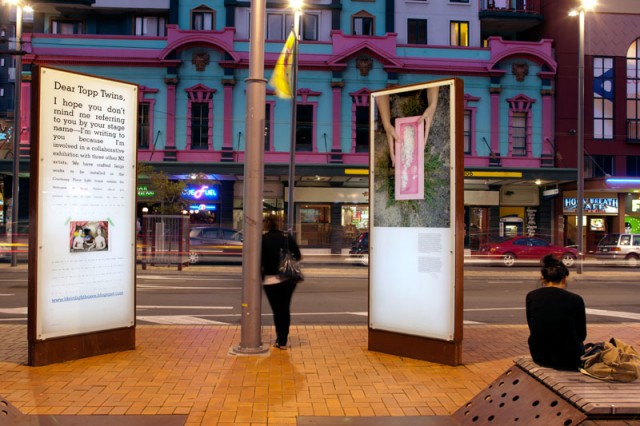
When I saw the first image, with a letter to the Topp Twins, I have to tell you that I shrieked out loud. I saw a documentary about them in Chicago. Lesbian yodelling comedic twins! Are. you. kidding. How great. Anyway! Did they write you back? Does everyone in NZ love them, or is it mostly just the homos?
Liz: Yeah, the Topp Twins would be a hell of a concept pitch. Luckily, they were a naturally occurring phenomenon and are now a national treasure. It’s cause they really get the whole performance of gender thing – and they do it with class too – they tackle all the national archetypes, but mostly it’s cause they are. just. so. goddam. funny! But unfortunately for us, lesbian, yodelling, comedic twins who are this successful are very busy and so we only had contact through their manager. À la Linda Evangelista, tha grrrls won’t get outta bed for less than $10,000. And all power to that.
Rachel: When I was little it always confused me that they were lesbian sisters, like wow, little-me thought, two lesbians in one family! Is that even possible?
Marnie: They were the first feminist comedy act I ever saw. It was 1987 in small, lakeside Taupo. All I remember from the performance was an armpit hair joke. One of the twins had one shaved armpit, and the other armpit au naturale. She raised one arm towards the audience and said, ‘Now you see it,’ then the other, ‘now you don’t’. Oh, and I think they were also BBQ-ing sausages on stage. World famous in New Zealand. Perhaps they are our very own Ellen DeGeneres?
Clare: Yes! I remember seeing that very performance very young, on early evening television, with my parents (… in the skit they put bread, sausages, and tomato sauce in a napkin for the usual meat demographic, bread and tomato sauce in a napkin for the vegos, and tomato sauce in a napkin for the vegans.)
But yes, the Topp Twins had a definite general audience reach throughout NZ, and were household names in the ‘80s, but when I think about their performances entering households via national broadcast, I can’t remember and wonder if their sexual orientation really was part of the household conversation at this time. After all, in 1987 New Zealand was only one year post homo-law-reform.
Rachel: I’m amazed at what a loyal following they have in NZ, especially their straight rural fan-base (being a gay girl from the country once-upon-a-time myself (cue barnyard sound effect)). I’m pretty interested in the rural/urban dynamic the Twins play off and, like Liz and Marnie say, the gender stuff they do is just radical. I think the Topp Twins are an example of a performance duo that uses their sexual identity as a really positive representational force to generate creative possibilities.
Sorry to be a literalist, but…what used to be in the pink box?
Liz: Clitoral stimulator. But we like the ambiguity!
I love the nipple pinch hotline, I feel that should be a real thing. A hotline for queer girls who want to pinch nipples. Tell me that’s what you’re working on next.
Liz: Absolutely. We’re just waiting on our creative funding.
Marnie: I really love the way you read that image. One thing that we tried to do with the project was play with suggestive and ambiguous relationships between images and text. In part as a way to echo the strategies that are used by advertising, pop, and web culture. We tried to take these strategies and intervene with an image/text ambiguity that would create a fun and subversive backdoor for queer cultures.
Rachel: The painting is by an unknown sixteenth-century artist and it’s rumoured (no one knows for sure) to represent the impending pregnancy and lactation of the woman whose nipple is being pinched by her sister-inlaw. This seems as crazy an interpretation as any other, so hey, why not just see two women having an effing good time in the bath together?
The light box works channel the pleasure (potentially) represented in this painting. I think Marnie describes it best when she said recently that our works embody pleasure as a valid form of critique. We’d also like to thank feminism.
Marnie: Yes, I really respond to Kathleen Hanna when she talks about pleasure and politics as exciting bedfellows and Emily Roysdon’s practice of ‘ecstatic resistance’ as modes of being that see joy and sexiness as a essential part of the critique of hetero-normative society and power. In many ways I think LGBTI visibility and the fight for equal rights has now become part of the mainstream media network, politics, and the market. I think this is super significant in terms of the kind of change this enables, but I also think that part of what our light box project did was to not assume that participation in mainstream culture means that you also have to take the structures of visibility that come with it as a given.
The line ‘one of the women stops and taps my rib with the soft toe of her shoe’ is deeply creepy. I hope you’re aware. What’s going on in the background? And does that girl smell like fresh laundry? Her shirt is looking very crisp there.
Liz: I relate to this work as a lesbian reference to the biblical Eve’s rib – uneasiness oozing from the conflict with anti-homo Christian morality. To emphasise this, the text is strewn with words like effaced, unseen, shadowed, unreadable, and the background figure is masking with hands, tumbling, turbulent; caught lo-res (and starched) behind the screen. I read all of these layers of reflection as a claustrophobic state, in which the woman pictured becomes her own fictional subject – willfully writing herself out while using the webcam as canvas.
Rachel: Yeah, the words are from a poem that our Ministry of Creepy Lines intercepted. We liked the words so much we decided to use them for our own purposes in conjunction with a contemporary hand/home-webcam dance action. Liz, that was a great reading of the subject object plays going on here!
Marnie: Hehe. I think Rachel for sure hand-washes her laundry more often than all the Brontë sisters combined.
Rachel: Actually, the reason you can smell the girl’s crisp laundry is thanks to the technical genius of fellow stunt Clare. If she wants you to smell the grass clippings on a pixel, you will.
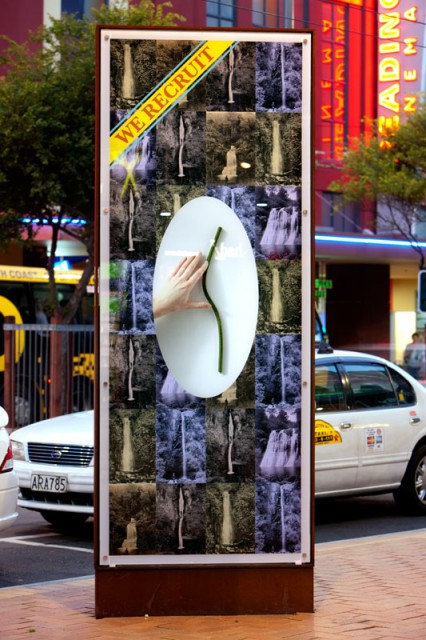
OMG the ‘We Recruit’ poster. The waterfalls are hypnotic. Is the pipey thing in the middle bent because it’s not straight? Is that a stupid question? Maybe everyone else immediately got that.
Liz: OMG – thanks, it’s one of our faves. The bent pipey thing: we did a poll – apparently the gays didn’t get that one…
Marnie: The bendy thing is apparently called a lesbian rule. Which we do, obviously.
Rachel: Yeah, when you’re making light box works about female same sex experience you go to the dictionary and look up the word lesbian, er, at least I did! When we next Skyped, I said, hey stunts, the dictionary says there’s this thing called a lesbian rule, and it’s basically ‘a mason’s rule of lead, of a type used on Lesbos, which could be bent to fit the curves of a moulding.’ As I said this, Clare (Skyping from the EU) said, yeah, hang on a minute, I’ve got one of those, and she turned around and picked up a lesbian rule from her desk. Clare is always well equipped for all occasions but this was going above and beyond the call of duty. It was a stunning moment.
Liz: Sure was. The works all use a combination of imagery, from the widely accessible to the cryptic, to connect with different public audiences. We discovered the concept of ‘gay window advertising’, which is where products are covertly marketed to a queer audience by the use of a gay subtext, enabling advertisers to get a wider market share without alienating the straight audience. So by taking the usual hetero-normal story + gay subtext equation and mixing it up, the works provided layers of recognisable homo-normative stories with AtCS’ special brand of xtra-gay subtext. And voilà! Your immediate recognition of the hypnotic powers of the er, waterfalls, is your access to the homo-text. The bent pipe sure ain’t straight and it’s also the outline of a breast: Ceci n’est pas une pipe? – but p’raps you’re just not a pipe woman ;)
Marnie: Besides, aren’t all lesbians obsessed with hands?
Clare: Early pioneering spirit meets tourism; WE RECRUIT seemed an appropriate juxtaposition, making fun and calling the bluff of popular stereotypes… including implicating our own! Unleashing the personified hypnotic powers of these portrait-format landscapes seemed a natural progression. And these shy beuwties from Niu Zuilund come in different shapes and shades of the gay shroud veil.
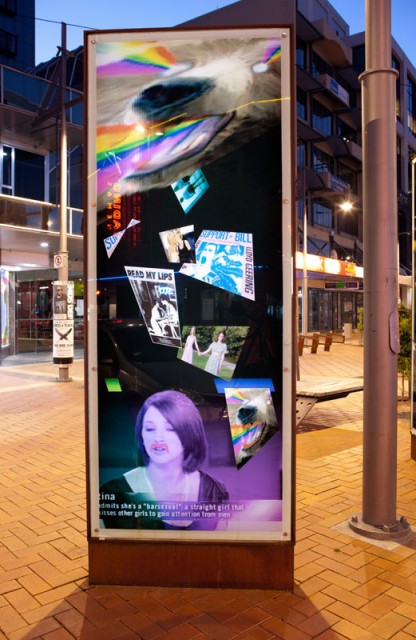
I totally saw the ‘barbian’ Tyra episode! Someone forwarded it to me. Well done with the moustache defacement. A barbian? What the fuck? I mean, what the fucking fuck?
Rachel: Glad you like the moustache – can’t go wrong with a touch of ‘90s Photoshop graffiti drag.
Liz: Yes, Tina the barbian, whom we have tinted purple and turquoise, seems oblivious to the cascade of pixilated geometric planes behind her. Containing images from our recent history, some are milestones in the homosexual rights movement and others belong to the more recent media uptake and kidnapping of lesbianism. Two rainbow-emitting bears watch over this media-filled space where stereo/archetypes are forming and where the images duke it out for visibility and influence. Our lo-res styling reflects a raw, always passionate, sometimes clumsy, and often agitated process. With a little help from the riot grrrl aesthetic, Tina’s masquerade ‘bluff’, as Clare so cunningly put it earlier, has been called out.
Are you as annoyed by Katy Perry as I am?
Marnie: She actually performed in Wellington a little while after the project finished! I think the pop music flirt with les’ sexy is downright annoying. Perhaps we were trying to flirt back?
Liz: LOL! Our Katy Perry work is definitely a quick-witted reply to the lame (and sinister) undertones of her infamous pop song. Perhaps by suggestively offering a better and more real outcome to Perry’s I kissed a girl scenario, we were flirting. Spooky. Her song and its video clip are perfectly exasperating examples of the way the popular media likes to present female same-sex attraction: in the service of heterosexuality. So, like in Perry’s song, lesbian desire is often reduced to an act of titillation (and a deviant one) for the attentions of an on-looking boyfriend. In this contemporary era of greater media visibility for gayness the quality of representation has not necessarily improved, and so the greater visibility can feel like an assault.
Clare: With our alternative version of the song’s lyrics, written in SMS language and in the first person, we are implying that an ‘other’ exists in Katy Perry land. Our intention was to re-confuse the confusion by being radical with identity politics for the purpose of marketing grrrr(l/!), (er, if you follow me?).
Rachel: There’s this bit in the music video where Perry picks up a cat and strokes it in her lap. I’m all for double triple bypass innuendo but at the same time I want to stand in front of YouTube and shout like a person with pride, ‘No, k8ty perry! Thou shan’t put a cat where my pussy is!’
- ‘All the Cunning Stunts’ The curator is Mary-Jane Duffy and the artists are: Liz Allan, Clare Noonan, Rachel O’Neill and Marnie Slater
- ‘All the Cunning Stunts’ The curator is Mary-Jane Duffy and the artists are: Liz Allan, Clare Noonan, Rachel O’Neill and Marnie Slater
- ‘All the Cunning Stunts’ The curator is Mary-Jane Duffy and the artists are: Liz Allan, Clare Noonan, Rachel O’Neill and Marnie Slater
- ‘All the Cunning Stunts’ The curator is Mary-Jane Duffy and the artists are: Liz Allan, Clare Noonan, Rachel O’Neill and Marnie Slater
- ‘All the Cunning Stunts’ The curator is Mary-Jane Duffy and the artists are: Liz Allan, Clare Noonan, Rachel O’Neill and Marnie Slater
- ‘All the Cunning Stunts’ The curator is Mary-Jane Duffy and the artists are: Liz Allan, Clare Noonan, Rachel O’Neill and Marnie Slater
All the Cunning Stunts, 2010. Images courtesy of Wellington City Council. Photographer: Neil Price
![]()
New Zealand artists Liz Allan, Rachel O’Neill, Clare Noonan and Marnie of All the Cunning Stunts (AtCS) share a collective enthusiasm for the way queer representation informs and is informed by pop culture and identity politics. Stalk, er, follow them, on Facebook or research blog.
AtCS are interviewed here by effing dykes blog queen and Chicago-based writer Krista Burton. If you haven’t visited effingdykes.blogspot.com (“YOUR GIRL GAYDAR SUCKS. LET ME HELP YOU.”) we suggest you do so, as in, now. AtCS stumbled across Krista’s gold mine of lesbian musings during their ‘research’ phase and were absolutely beguiled by her abitlity to move from personal to homo-versal in such an effortless scrolling fashion (F+!). At the end of every post Krista throws open the conversation to the LGBQTI community online by asking a leading question…
The publication SO GAY! was launched in Wellington, New Zealand in December 2011. Colour-filled highlights inside the modesty shield-cum-publication-cover include a centrefold of audience favourite “k8y perry dmpd me 4 a str8 grrl”; this lively Q&A with Krista Burton; a personal essay by curator Mary-Jane Duffy, a commissioned poem by NY poet Alan Felsenthal, and a splash of double-signed trouble from the Topp Twins. To know more, haul ass here, or send an email to allthecunningstunts(at)gmail(dot)com.

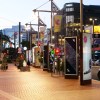

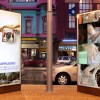
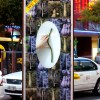
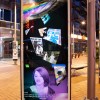
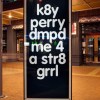

I’ll be honest here, when I read Cunning Stunts my brain switched up the first letters.
I think that was the point?
Also, there was a picture of me on one of the panels a while back! It was one of my school year, in uniform, all about to jump off the wharf into the sea (end of year, last year of uniform).
This was an awesome article, they seem great!
Does everyone else keep hearing ‘Stunning Cunts’ in they’re head when they read Cunning Stunts?
It was hard for me to even type it right.
yep. Stunning Cunts, every single time I re-read it. That’d be a pretty awesome band name.
…now i’m thinking in a NZ accent. A poor one at that.
What what what. I walk past those lightboxes literally every. single. day. on my way to work, why in the name of all that’s holy did I NOT see this? (I feel like maybe it was on just before I moved to Wellington …) *sad face*
Also, Krista, I will love you forever and ever if you come to New Zealand and speak to the queers of Wellington.
Also, do people find the NZ accent cute? Cos I have one hell of a Kiwi accent ;)
And lastly – a note on the ‘cunt’ joke … (yes, you are meant to confuse it with ‘Stunning Cunts’ – it’s like the ‘You this read wrong’ thing) – I’m not sure whether these girls were using it in this sense, but: yes, it’s still considered a particularly taboo word among the over-thirties, etc. But the majority of my contemporaries use it freely, easily and daily – sometimes to insult, but far more often to praise: if someone is a ‘good cunt’ or a ‘good bitch’, it means the are a really decent sort of person, the sort that will lend you money and buy you drinks and smoke weed with you and party hard and carry you home. Even as an insult though, it has taken on a completely different meaning to its original one, which I find very interesting. I don’t know if the same sort of usage applies in America …
New Zealand and Effing Dykes and hilarious spoonerisms and cool art… this post has all my favourite things!
I mean, spilarious hoonerisms.
Pretty component of content. I just stumbled
upon your blog and in accession capital to assert that I acquire
in fact enjoyed account your blog posts. Any way I’ll be subscribing on your augment or
even I achievement you get right of entry to persistently fast.